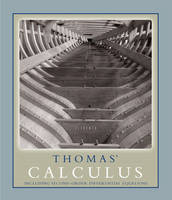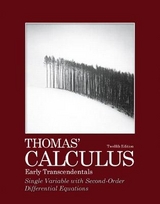
Thomas' Calculus including Second-order Differential Equations
Pearson (Verlag)
978-0-321-49069-8 (ISBN)
- Titel ist leider vergriffen;
keine Neuauflage - Artikel merken
Thomas’ Calculus including Second-order Differential Equations is now available with an enhanced MyMathLab™ course–the ultimate homework, tutorial and study solution for today’s students. The enhanced MyMathLab™ course includes a rich and flexible set of course materials and features innovative Java™ Applets, Group Projects, and new MathXL® exercises. This text is also available with WebAssign® and WeBWorK®.
(Practice Exercises, Additional Exercises, and Questions to Guide Your Review appear at the end of each chapter.)
Preliminaries
Real Numbers and the Real Line
Lines, Circles, and Parabolas
Functions and Their Graphs
Identifying Functions; Mathematical Models
Combining Functions; Shifting and Scaling Graphs
Trigonometric Functions
Graphing with Calculators and Computers
2. Limits and Derivatives
Rates of Change and Limits
Calculating Limits Using the Limit Laws
Precise Definition of a Limit
One-Sided Limits and Limits at Infinity
Infinite Limits and Vertical Asymptotes
Continuity
Tangents and Derivatives
3. Differentiation
The Derivative as a Function
Differentiation Rules
The Derivative as a Rate of Change
Derivatives of Trigonometric Functions
The Chain Rule and Parametric Equations
Implicit Differentiation
Related Rates
Linearization and Differentials
4. Applications of Derivatives
Extreme Values of Functions
The Mean Value Theorem
Monotonic Functions and the First Derivative Test
Concavity and Curve Sketching
Applied Optimization Problems
Indeterminate Forms and L'Hopital's Rule
Newton's Method
Antiderivatives
5. Integration
Estimating with Finite Sums
Sigma Notation and Limits of Finite Sums
The Definite Integral
The Fundamental Theorem of Calculus
Indefinite Integrals and the Substitution Rule
Substitution and Area Between Curves
6. Applications of Definite Integrals
Volumes by Slicing and Rotation About an Axis
Volumes by Cylindrical Shells
Lengths of Plane Curves
Moments and Centers of Mass
Areas of Surfaces of Revolution and The Theorems of Pappus
Work
Fluid Pressures and Forces
7. Transcendental Functions
Inverse Functions and their Derivatives
Natural Logarithms
The Exponential Function
ax and loga x
Exponential Growth and Decay
Relative Rates of Growth
Inverse Trigonometric Functions
Hyperbolic Functions
8. Techniques of Integration
Basic Integration Formulas
Integration by Parts
Integration of Rational Functions by Partial Fractions
Trigonometric Integrals
Trigonometric Substitutions
Integral Tables and Computer Algebra Systems
Numerical Integration
Improper Integrals
9. Further Applications of Integration
Slope Fields and Separable Differential Equations
First-Order Linear Differential Equations
Euler's Method
Graphical Solutions of Autonomous Equations
Applications of First-Order Differential Equations
10. Conic Sections and Polar Coordinates
Conic Sections and Quadratic Equations
Classifying Conic Sections by Eccentricity
Quadratic Equations and Rotations
Conics and Parametric Equations; The Cycloid
Polar Coordinates
Graphing in Polar Coordinates
Area and Lengths in Polar Coordinates
Conic Sections in Polar Coordinates
11. Infinite Sequences and Series
Sequences
Infinite Series
The Integral Test
Comparison Tests
The Ratio and Root Tests
Alternating Series, Absolute and Conditional Convergence
Power Series
Taylor and Maclaurin Series
Convergence of Taylor Series; Error Estimates
Applications of Power Series
Fourier Series
12. Vectors and the Geometry of Space
Three-Dimensional Coordinate Systems
Vectors
The Dot Product
The Cross Product
Lines and Planes in Space
Cylinders and Quadric Surfaces
13. Vector-Valued Functions and Motion in Space
Vector Functions
Modeling Projectile Motion
Arc Length and the Unit Tangent Vector T
Curvature and the Unit Normal Vector N
Torsion and the Unit Binormal Vector B
Planetary Motion and Satellites
14. Partial Derivatives
Functions of Several Variables
Limits and Continuity in Higher Dimensions
Partial Derivatives
The Chain Rule
Directional Derivatives and Gradient Vectors
Tangent Planes and Differentials
Extreme Values and Saddle Points
Lagrange Multipliers
*Partial Derivatives with Constrained Variables
Taylor's Formula for Two Variables
15. Multiple Integrals
Double Integrals
Areas, Moments and Centers of Mass*
Double Integrals in Polar Form
Triple Integrals in Rectangular Coordinates
Masses and Moments in Three Dimensions
Triple Integrals in Cylindrical and Spherical Coordinates
Substitutions in Multiple Integrals
16. Integration in Vector Fields
Line Integrals
Vector Fields, Work, Circulation, and Flux
Path Independence, Potential Functions, and Conservative Fields
Green's Theorem in the Plane
Surface Area and Surface Integrals
Parametrized Surfaces
Stokes' Theorem
The Divergence Theorem and a Unified Theory
Appendices
Mathematical Induction
Proofs of Limit Theorems
Commonly Occurring Limits
Theory of the Real Numbers
Complex Numbers
The Distributive Law for Vector Cross Products
Determinants and Cramer's Rule
The Mixed Derivative Theorem and the Increment Theorem
The Area of a Parallelogram's Projection on a Plane
17. Second-order Differential Equations
Second-Order Linear Equations
Nonhomogeneous Linear Equations
Applications
Euler Equations
Power-Series Solutions
| Erscheint lt. Verlag | 11.7.2007 |
|---|---|
| Sprache | englisch |
| Maße | 262 x 225 mm |
| Gewicht | 2792 g |
| Themenwelt | Mathematik / Informatik ► Mathematik ► Analysis |
| ISBN-10 | 0-321-49069-X / 032149069X |
| ISBN-13 | 978-0-321-49069-8 / 9780321490698 |
| Zustand | Neuware |
| Informationen gemäß Produktsicherheitsverordnung (GPSR) | |
| Haben Sie eine Frage zum Produkt? |
aus dem Bereich



